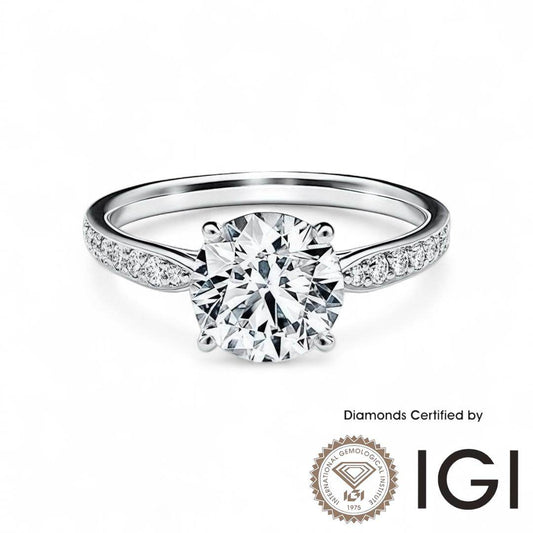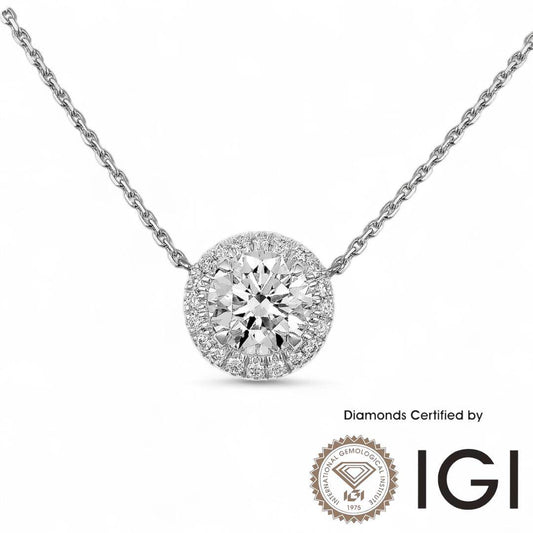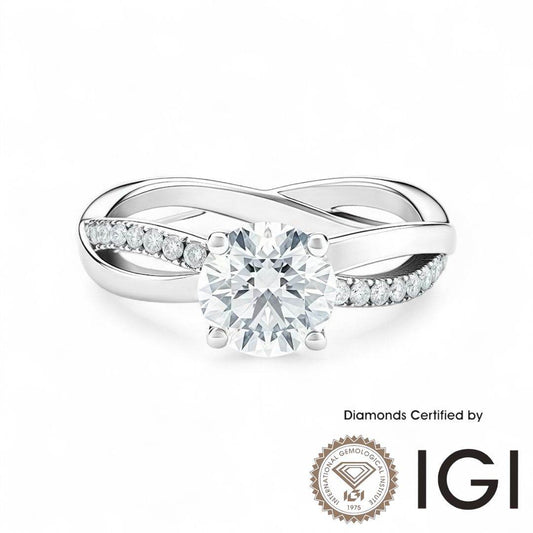What Are Lab-Grown Diamonds? Difference vs Natural
Lab-grown diamonds are real diamonds that are manufactured in controlled laboratory environments using HPHT or CVD technology. They are chemically, physically and optically equivalent to natural diamonds and are graded using the same 4Cs framework by reputable gemological laboratories. This guide explains production methods, grading, sustainability considerations, and practical buying advice to establish trust when purchasing lab-grown stones.
What are Lab-Grown Diamonds?
Lab-grown diamonds (also called laboratory-created, synthetic, or cultivated diamonds) are true diamonds composed of crystalline carbon in the same cubic structure as mined diamonds. They are not simulants (like cubic zirconia or moissanite); instead, they have the same chemical composition, hardness (10 on the Mohs scale), refractive index, and optical properties as natural diamonds.
Reputable gemological authorities confirm that lab-grown diamonds are real diamonds, but disclosure of origin—lab vs natural—is essential for transparent commerce. See the Gemological Institute of America (GIA) and International Gemological Institute (IGI) statements for official guidance: GIA, IGI.
How Lab-Grown Diamonds Are Produced
Two principal industrial methods produce gem-quality diamonds: High Pressure High Temperature (HPHT) and Chemical Vapor Deposition (CVD). Both yield stones that, after cutting and polishing, are chemically and optically identical to natural diamonds. The growth environment and resulting trace signatures, however, differ and are recorded on many grading reports.
HPHT — Overview
HPHT recreates the high pressure and temperature conditions of the Earth’s mantle. Carbon (graphite or diamond seed) is subjected to pressures of several gigapascals and temperatures above 1,200°C inside a press. Under these conditions the carbon atoms crystallize into diamond.
Common characteristics: Good for producing denser, sometimes colored diamonds. May leave metallic flux inclusions depending on the process variant used.
CVD — Overview
CVD uses a hydrocarbon gas mixture (typically methane + hydrogen) in a vacuum chamber. Plasma energy breaks down gas molecules and deposits carbon atoms onto a diamond substrate, building the crystal layer by layer.
Common characteristics: Very controlled color and clarity outcomes; favorable for large, near-colorless stones and technical control of nitrogen and other impurities.
Technical distinctions that matter to buyers
- Trace signatures: Laboratories identify growth method and any post-growth treatment (e.g., HPHT color improvements).
- Post-growth treatments: Some stones undergo annealing or HPHT to improve color—proper disclosure on the report is required.
- Inscription and traceability: Many lab diamonds carry microscopic laser inscriptions linking them to a certificate number for full traceability.
Lab-Grown vs Natural Diamonds — Key Comparisons
From a strictly mineralogical perspective, there is no chemical difference between a lab-grown and a natural diamond. Differentiation for consumers and the trade is therefore based on origin, trace signatures, market value, and perception.
| Feature | Lab-Grown Diamond | Natural Diamond |
|---|---|---|
| Origin | Manufactured in controlled laboratory environments (HPHT or CVD). | Formed naturally in the Earth over millions to billions of years; mined from primary or alluvial sources. |
| Chemical & Physical Properties | Identical to natural diamonds (carbon crystal, same hardness and refractive properties). | Identical mineral properties; natural trace impurities from geological processes. |
| Certification | Graded by GIA, IGI, HRD and others; reports specify growth method and treatments. | Graded by the same labs; natural origin noted on the report. |
| Price | Typically 60–90% less than comparable natural stones, depending on market conditions and size. | Higher price reflecting scarcity, established secondary market, and cultural perceptions. |
| Environmental & Ethical | Lower mining-related habitat disruption; carbon footprint depends on energy sources used in production. | Mining impacts vary; some mines and supply chains have strong social and environmental programs, others less so. |
| Resale & Investment | Secondary market is developing; historically lower resale value vs natural diamonds. | Established resale, auction and collectible markets with stronger historical price resilience. |
Quality, The 4Cs, and Certification
Regardless of origin, the 4Cs — Cut, Color, Clarity, Carat — remain the universal framework for assessing a diamond’s quality and desirability. What changes for lab-grown stones is the labeling on the grading report: labs will indicate growth method (HPHT or CVD) and any treatments.
Cut
Cut determines brilliance and is a function of proportions, symmetry, and polish. Top cut grades (Excellent/Ideal or 3EX) are the most important factor for perceived sparkle, sometimes more so than small differences in color or clarity.
Color
Diamonds are graded on a scale from D (colorless) to Z (light yellow/brown). Many lab-grown diamonds are produced in high color grades (D–F) though manufacturing nuances and post-growth treatments affect outcomes. Independent certification should always state color grade and any treatments.
Clarity
Clarity measures inclusions and blemishes. High-clarity lab diamonds (VVS, VS) are common; growth processes may create characteristic inclusions which gem labs identify and report.
Carat
Carat is weight. The cost increases non-linearly with carat weight; lab manufacturing makes certain larger sizes more accessible than historically affordable in the natural market.
Certification: Why it matters
Certification from an independent, recognized laboratory is non-negotiable. Certificates are the primary credential buyers use to verify quality and origin. Leading labs include:
- GIA — the international reference for grading standards. See gia.edu.
- IGI — a major global lab that explicitly certifies lab-grown diamonds and records growth method and inscriptions. See igi.org.
- HRD Antwerp — a European lab with robust grading protocols. See hrdantwerp.com.
Industry guidance: the U.S. Federal Trade Commission (FTC) requires clear disclosure of a diamond’s origin to prevent misleading marketing. For official guidance see ftc.gov.
Sustainability, Ethics, and Environmental Considerations
One of the principal motivations for buyers choosing lab-grown diamonds is ethical sourcing and reduced environmental impact compared with some mining operations. However, sustainability for lab diamonds depends on energy inputs and water usage during production.
Key sustainability points
- Conflict-free origin: Lab production eliminates risks associated with armed conflict or exploitative labor in diamond mining.
- Energy source matters: If production uses renewable energy, the carbon footprint is substantially lower than many mined alternatives. Some producers publish lifecycle assessments; request this data when comparing suppliers.
- Responsible jewellery frameworks: The Responsible Jewellery Council (RJC) and other standards bodies set best practices for traceability and ethical procurement. See Responsible Jewellery Council.
“Sustainability claims should be supported by transparent, independently verifiable evidence—energy sourcing, lifecycle assessments, and chain-of-custody documentation.”
Practical Buying Guide — How to Buy Lab-Grown Diamonds with Confidence
Before you shop
- Define priorities: Decide whether color, clarity, size (carat), or cut is most important for your budget and aesthetic.
- Set a budget: Lab-grown stones offer better value at most price points; however, quality dispersions still apply—allocate more budget to cut and certification.
- Understand certification: Always insist on a certificate from a reputable lab. Confirm the certificate number via the lab’s online report lookup if available.
At the point of sale — essential checks
- Certificate verification: Match the laser inscription on the girdle to the certificate number and confirm via the issuing lab.
- Disclosure of growth method: The report should clearly state HPHT or CVD and list any treatments.
- Return policy and warranty: Confirm 14–30 day inspection/return and longer warranties for mounting and services.
- Third-party appraisal: For higher-value purchases, obtain an independent appraisal for insurance and resale documentation.
Negotiation and pricing
Because the lab-grown market is still maturing, pricing varies widely by vendor. Use certificate grade, cut grade, and comparable market listings to benchmark value. For high-clarity, large carat stones, the savings vs natural diamonds will be most noticeable; smaller stones sometimes show narrower differentials.
Custom settings and metal choices
When adding a setting, consider metal compatibility (14K/18K gold, platinum PT950) and long-term care. Placing a lab-grown center stone in a certified setting with documented warranty preserves value and buyer confidence.
Market Context & Consumer Trends (Global)
Demand for lab-grown diamonds has broadened from fashion and statement jewelry into mainstream engagement and bridal segments. Younger consumers often prioritize sustainability and transparency, accelerating adoption in many regions. At the same time, resale and investment markets remain more established for natural diamonds—this is an important distinction for buyers whose primary objective is capital appreciation.
Common Misconceptions — Clarified
- “Lab diamonds are fake.” Incorrect: lab diamonds are chemically identical to natural diamonds and are not simulants.
- “Lab diamonds are always lower quality.” Incorrect: manufacturing allows precise control; many lab stones exceed typical natural quality for given price points.
- “They’re not graded.” Incorrect: reputable labs grade lab diamonds and indicate growth method and treatments on reports.
Risks and Limitations Buyers Should Know
To build trust, transparently acknowledge market limitations:
- Secondary market liquidity: Fewer established resale channels historically—verify buyback policies and market offers if resale value matters.
- Quality variation between producers: Process control and post-growth treatments vary—certificates and vendor transparency mitigate risk.
- Energy footprint variance: Ask suppliers for energy sourcing and lifecycle data if environmental impact is a purchasing criterion.
How Laboratories Tell Lab-Grown from Natural
Gemological laboratories use specialized equipment (spectroscopy, photoluminescence, and microscopic inclusion analysis) to detect growth patterns, trace elements, and manufacturing artefacts. Those signatures allow definitive identification of growth method and any treatments. This is why a laboratory report from an established lab is essential to verify origin.
Use Cases: When Lab-Grown Diamonds Make the Most Sense
- Value-focused buyers: Larger center stones at a fraction of the natural diamond price.
- Sustainability-minded couples: If minimized mining impact and transparent sourcing are priorities.
- Fashion and everyday luxury: Stones used as daily wear where cost-effective replacement or style rotation is attractive.
- High precision design: When specific color or clarity characteristics are required and can be engineered in production.
After-Sale Care, Certification Storage and Insurance
Retain certificates and laser inscriptions, and insure higher-value pieces. Use certified appraisers for replacement-value appraisals and confirm warranty coverage for settings and services. Routine maintenance—professional cleaning and periodic inspections—prolongs appearance and structural integrity.
Frequently Asked Questions
1. Are lab-grown diamonds real diamonds?
Yes. Lab-grown diamonds are chemically, physically, and optically identical to natural diamonds. Reputable gemological laboratories will identify the growth method on the grading report, ensuring transparent disclosure of origin.
2. How do lab-grown diamonds compare in price and resale value?
Lab-grown diamonds typically sell for significantly less than natural diamonds of comparable 4Cs—often 30–70% less, depending on size and quality. The secondary market for lab-grown diamonds is still maturing, so resale values may be lower than natural diamonds; buyers should purchase primarily for personal value and aesthetics rather than guaranteed financial appreciation.
3. Which is better — HPHT or CVD?
Neither method is universally “better”; each has advantages. CVD offers fine control for large, near-colorless stones, while HPHT can produce stones with different natural-looking color profiles and certain technical benefits. Choose based on certificate results (4Cs, treatments listed) rather than the growth method alone.
4. Are lab-grown diamonds better for the environment?
Lab-grown diamonds often reduce impacts associated with mining (habitat disruption, tailings). However, their environmental advantage depends on production energy sources and manufacturing processes. Look for suppliers who provide lifecycle assessments and use renewable energy to maximize environmental benefits.
5. How can I verify a lab-grown diamond’s authenticity?
Require a certificate from a recognized lab (GIA, IGI, HRD). Verify the certificate number with the lab and match it to any laser inscription on the stone’s girdle. Confirm return policies, warranties, and ask for evidence of chain-of-custody or production documentation for maximum transparency.
About MadisonDia & Author
MadisonDia is the lab-grown diamond division of Madison Avenue (a luxury boutique and distributor). Our procurement team sources stones that meet strict technical and ethical standards; every listed stone is accompanied by an independent laboratory report.
Selected Authoritative Resources
For further reading and official guidance, consult the following institutions and standards organizations:
- Gemological Institute of America (GIA) — Grading standards and lab-grown diamond resources.
- International Gemological Institute (IGI) — Certification for lab-grown diamonds and identification services.
- Federal Trade Commission (FTC) — Guidelines on truthful marketing and disclosure.
- Responsible Jewellery Council (RJC) — Responsible sourcing best practices.
- HRD Antwerp — Independent grading and reporting services.
Final Recommendations — Buyer Checklist
- Always purchase with a lab report from GIA, IGI, HRD or equivalent.
- Verify laser inscription against the certificate number.
- Prioritize cut and proportion for visible brilliance over small color/clarity differences.
- Request energy-use or lifecycle data if sustainability matters to you.
- Confirm return, inspection, and warranty terms in writing.
If you would like a tailored selection of lab-grown diamonds that match a specific 4C profile and budget, MadisonDia’s sourcing team can prepare a verified list with certificate links and lifecycle documentation upon request. Contact our team





